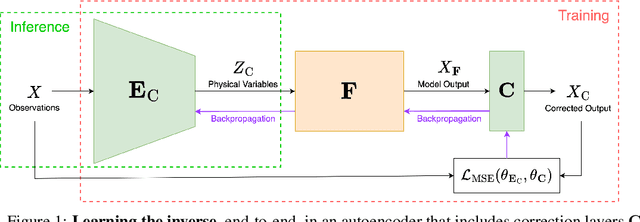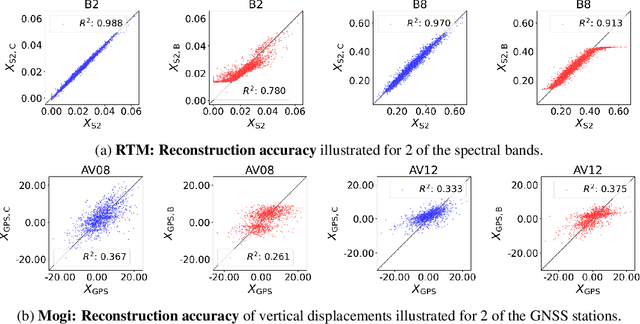Clement Atzberger
MAGIC: Modular Auto-encoder for Generalisable Model Inversion with Bias Corrections
May 29, 2024



Abstract:Scientists often model physical processes to understand the natural world and uncover the causation behind observations. Due to unavoidable simplification, discrepancies often arise between model predictions and actual observations, in the form of systematic biases, whose impact varies with model completeness. Classical model inversion methods such as Bayesian inference or regressive neural networks tend either to overlook biases or make assumptions about their nature during data preprocessing, potentially leading to implausible results. Inspired by recent work in inverse graphics, we replace the decoder stage of a standard autoencoder with a physical model followed by a bias-correction layer. This generalisable approach simultaneously inverts the model and corrects its biases in an end-to-end manner without making strong assumptions about the nature of the biases. We demonstrate the effectiveness of our approach using two physical models from disparate domains: a complex radiative transfer model from remote sensing; and a volcanic deformation model from geodesy. Our method matches or surpasses results from classical approaches without requiring biases to be explicitly filtered out, suggesting an effective pathway for understanding the causation of various physical processes.
From Spectra to Biophysical Insights: End-to-End Learning with a Biased Radiative Transfer Model
Mar 05, 2024



Abstract:Advances in machine learning have boosted the use of Earth observation data for climate change research. Yet, the interpretability of machine-learned representations remains a challenge, particularly in understanding forests' biophysical reactions to climate change. Traditional methods in remote sensing that invert radiative transfer models (RTMs) to retrieve biophysical variables from spectral data often fail to account for biases inherent in the RTM, especially for complex forests. We propose to integrate RTMs into an auto-encoder architecture, creating an end-to-end learning approach. Our method not only corrects biases in RTMs but also outperforms traditional techniques for variable retrieval like neural network regression. Furthermore, our framework has potential generally for inverting biased physical models. The code is available on https://github.com/yihshe/ai-refined-rtm.git.
A mixed model approach to drought prediction using artificial neural networks: Case of an operational drought monitoring environment
Jan 10, 2019



Abstract:Droughts, with their increasing frequency of occurrence, continue to negatively affect livelihoods and elements at risk. For example, the 2011 in drought in east Africa has caused massive losses document to have cost the Kenyan economy over $12bn. With the foregoing, the demand for ex-ante drought monitoring systems is ever-increasing. The study uses 10 precipitation and vegetation variables that are lagged over 1, 2 and 3-month time-steps to predict drought situations. In the model space search for the most predictive artificial neural network (ANN) model, as opposed to the traditional greedy search for the most predictive variables, we use the General Additive Model (GAM) approach. Together with a set of assumptions, we thereby reduce the cardinality of the space of models. Even though we build a total of 102 GAM models, only 21 have R2 greater than 0.7 and are thus subjected to the ANN process. The ANN process itself uses the brute-force approach that automatically partitions the training data into 10 sub-samples, builds the ANN models in these samples and evaluates their performance using multiple metrics. The results show the superiority of 1-month lag of the variables as compared to longer time lags of 2 and 3 months. The champion ANN model recorded an R2 of 0.78 in model testing using the out-of-sample data. This illustrates its ability to be a good predictor of drought situations 1-month ahead. Investigated as a classifier, the champion has a modest accuracy of 66% and a multi-class area under the ROC curve (AUROC) of 89.99%
 Add to Chrome
Add to Chrome Add to Firefox
Add to Firefox Add to Edge
Add to Edge